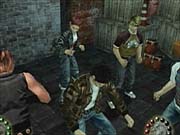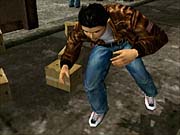Shenmue II Preview
We report on the final Japanese version of this anticipated game.
After making fans wait more than a year and a half, Sega released the second installment in Yu Suzuki's epic Shenmue last week in Japan. While the first chapter set Ryo Hazuki's adventures in the small Japanese town of Yokosuka--with little progress to the storyline to boot--most will be pleased by how Shenmue II for the Dreamcast has turned out. Your adventures begin as Ryo arrives in Hong Kong in order to find a martial artist by the name of Lishao Tao, who Ryo hopes will help him locate Yuanda Zhu, the person who sent the letter to Ryo's father in the original game. If you have a cleared save file from the first game, your items, skill moves, money, and date of departure to Hong Kong will be carried over. Those who happened to missed the first game can watch a summary movie that fills you in on the key events.

Simply put, Shenmue II is a natural extension of the first, but its pacing and the progression of its story are quite well executed when compared with those of its relatively slow-paced predecessor. There are more "quick timer events" (QTEs) and free battles, both of which start to occur early on in the game. This time, though, the story continues on even if you fail the QTEs, though you'll still have to fulfill the particular objective at a later date. For example, if you are chasing somebody in a QTE and you fail, you lose track of him, but you'll be given another chance to find the person at another time and location. There are still some instances, though, in which the QTE will keep looping until you fulfill it, similar to how it worked in the first game. There is also now a new type of QTE that's command-based, but due to the way it displays the required inputs onscreen, most players probably won't get it right the first time. And even after you've been exposed to it, it's hard to determine the timing required to properly execute the command. It becomes quite annoying when you keep failing this new type of QTE and it keeps looping infinitely--without allowing you to skip the cutscenes.
When you have spare time during the day, you have a lot more options to keep yourself entertained. In addition to playing the slot machines or hitting the arcades to play classic Sega games, you can visit one of the many vendors in Shenmue II's Hong Kong that allow you to gamble--you can play pinball-type games, you can roll dice, and you can even arm wrestle. You can also work carrying wooden crates in a QTE-type minigame, but you can find a more challenging job as an employee of the gambling vendors. If you choose such a job, you are given a certain amount of cash by the owner of the establishment, and your job is to lure potential customers in and play a pinball-type game against them. If you win, half of the earnings go to you. Luckily, even if you keep losing, you only lose the owner's money. But if you simply don't want to bother working, playing games, or gambling, you have the option to fast-forward time at particular instances to expedite the arrival of appointments and the like. Unfortunately, you can no longer use your spare time to visit a park and practice your moves to gain experience. The only places you can earn such experience are the free battles that crop up as your game progresses.
The interface in Shenmue II has become much more user-friendly, and it makes extensive use of the D-pad and the buttons on the controller. The icon selector assigns different actions to the A, B, X, and Y buttons, such as opening doors, talking to people, accessing the options menu, and accessing your memo notebook. When talking to somebody, Ryo also no longer asks the same question all the time. With the action selector, players have several choices they can make using the D-pad, like asking for directions, inquiring about jobs, or asking about a certain person. On a related note, the people are also more responsive--rather than making lame excuses and not answering your questions, some even walk with you to your destination, which is quite helpful in new areas. Better yet, you can buy maps in each area of the town and mark off places (in three different colors) you'd like to remember, be they related to key events or simply your favorite gambling vendors.

The early part of the game keeps you going at a steady pace, but it also allows for a fair amount of free time to get immersed in the Shenmue world. The environment is also much larger than the first game's. One prime example would be when you visit the Kowloon Towers later in the game. There are many buildings that have a dozen or more floors each, with several rooms or stores on each floor. Though only a fraction of these actually have something to do with the story, you can visit every single one of them in your spare time, if you so choose. Even arcades and gambling vendors are vast in number--players will undoubtedly find their own favorite spots once they start to memorize the layout of each vendor's pinball boards. Though Sega added many more details--such as decorative objects and more people onscreen--the overly colorful textures seem to depict Hong Kong a bit too unnaturally, especially when compared with the depiction of Yokosuka in the first game. It also seems that the polygon count per character has dropped, and a fair amount of fade-in has found its way into the game. Oftentimes, even if you're only a few steps away from a character, you won't realize you're about to bump into him or her until you're face-to-face. You might also notice a tighter compression on the audio of some of the dialogues, which makes things sound muffled. There have also been reports of bugs and freezes, despite the game being out in stores.

All in all, the game further develops the Shenmue plot and provides you with a great level of freedom to explore a vast environment. There are even options to shorten gameplay time, if you desire to do so. You will notice, though, that certain sacrifices have been made in the graphics and audio to ensure that the game runs efficiently on the Dreamcast hardware. Still, players should savor every single bite of the marvel that is Shenmue II, as there is very little news regarding future installments.
Got a news tip or want to contact us directly? Email news@gamespot.com
Join the conversation